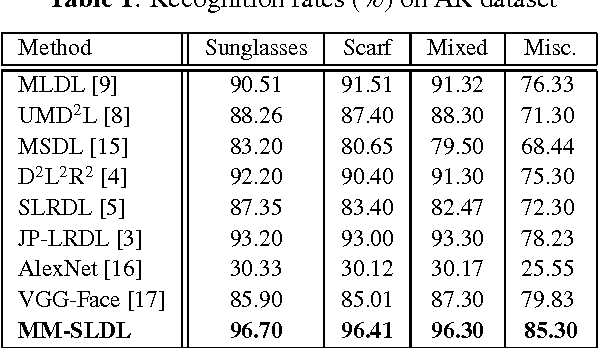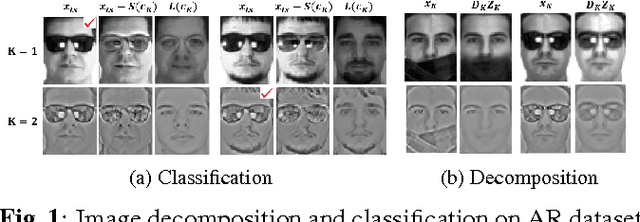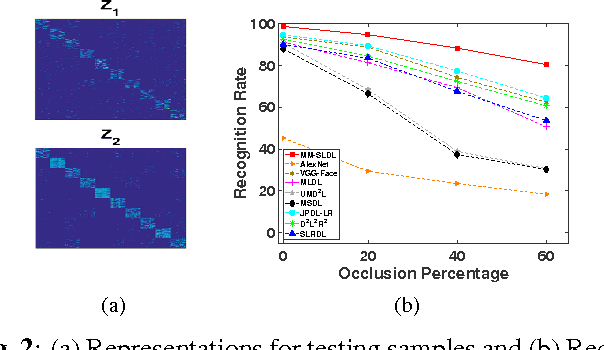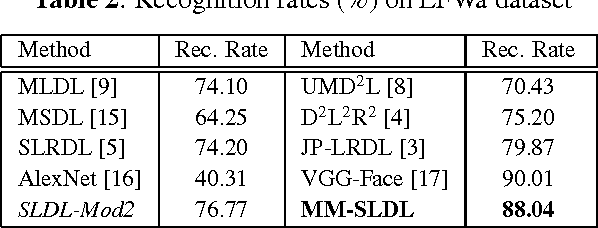Homa Foroughi
Face Recognition using Multi-Modal Low-Rank Dictionary Learning
Mar 15, 2017



Abstract:Face recognition has been widely studied due to its importance in different applications; however, most of the proposed methods fail when face images are occluded or captured under illumination and pose variations. Recently several low-rank dictionary learning methods have been proposed and achieved promising results for noisy observations. While these methods are mostly developed for single-modality scenarios, recent studies demonstrated the advantages of feature fusion from multiple inputs. We propose a multi-modal structured low-rank dictionary learning method for robust face recognition, using raw pixels of face images and their illumination invariant representation. The proposed method learns robust and discriminative representations from contaminated face images, even if there are few training samples with large intra-class variations. Extensive experiments on different datasets validate the superior performance and robustness of our method to severe illumination variations and occlusion.
Joint Projection and Dictionary Learning using Low-rank Regularization and Graph Constraints
Dec 06, 2016



Abstract:In this paper, we aim at learning simultaneously a discriminative dictionary and a robust projection matrix from noisy data. The joint learning, makes the learned projection and dictionary a better fit for each other, so a more accurate classification can be obtained. However, current prevailing joint dimensionality reduction and dictionary learning methods, would fail when the training samples are noisy or heavily corrupted. To address this issue, we propose a joint projection and dictionary learning using low-rank regularization and graph constraints (JPDL-LR). Specifically, the discrimination of the dictionary is achieved by imposing Fisher criterion on the coding coefficients. In addition, our method explicitly encodes the local structure of data by incorporating a graph regularization term, that further improves the discriminative ability of the projection matrix. Inspired by recent advances of low-rank representation for removing outliers and noise, we enforce a low-rank constraint on sub-dictionaries of all classes to make them more compact and robust to noise. Experimental results on several benchmark datasets verify the effectiveness and robustness of our method for both dimensionality reduction and image classification, especially when the data contains considerable noise or variations.
Object Classification with Joint Projection and Low-rank Dictionary Learning
Dec 05, 2016



Abstract:For an object classification system, the most critical obstacles towards real-world applications are often caused by large intra-class variability, arising from different lightings, occlusion and corruption, in limited sample sets. Most methods in the literature would fail when the training samples are heavily occluded, corrupted or have significant illumination or viewpoint variations. Besides, most of the existing methods and especially deep learning-based methods, need large training sets to achieve a satisfactory recognition performance. Although using the pre-trained network on a generic large-scale dataset and fine-tune it to the small-sized target dataset is a widely used technique, this would not help when the content of base and target datasets are very different. To address these issues, we propose a joint projection and low-rank dictionary learning method using dual graph constraints (JP-LRDL). The proposed joint learning method would enable us to learn the features on top of which dictionaries can be better learned, from the data with large intra-class variability. Specifically, a structured class-specific dictionary is learned and the discrimination is further improved by imposing a graph constraint on the coding coefficients, that maximizes the intra-class compactness and inter-class separability. We also enforce low-rank and structural incoherence constraints on sub-dictionaries to make them more compact and robust to variations and outliers and reduce the redundancy among them, respectively. To preserve the intrinsic structure of data and penalize unfavourable relationship among training samples simultaneously, we introduce a projection graph into the framework, which significantly enhances the discriminative ability of the projection matrix and makes the method robust to small-sized and high-dimensional datasets.
 Add to Chrome
Add to Chrome Add to Firefox
Add to Firefox Add to Edge
Add to Edge